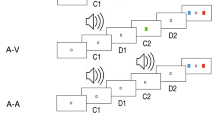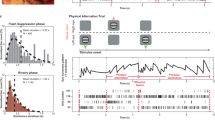Abstract
To make a visual discrimination, the brain must extract relevant information from the retina, represent appropriate variables in the visual cortex and read out this representation to decide which of two or more alternatives is more likely. We recorded from neurons in the dorsolateral prefrontal cortex (areas 8 and 46) of the rhesus monkey while it performed a motion discrimination task. The monkey indicated its judgment of direction by making appropriate eye movements. As the monkey viewed the motion stimulus, the neural response predicted the monkey's subsequent gaze shift, hence its judgment of direction. The response comprised a mixture of high–level oculomotor signals and weaker visual sensory signals that reflected the strength and direction of motion. This combination of sensory integration and motor planning could reflect the conversion of visual motion information into a categorical decision about direction and thus give insight into the neural computations behind a simple cognitive act.
This is a preview of subscription content, access via your institution
Access options
Subscribe to this journal
Receive 12 print issues and online access
$209.00 per year
only $17.42 per issue
Buy this article
- Purchase on Springer Link
- Instant access to full article PDF
Prices may be subject to local taxes which are calculated during checkout








Similar content being viewed by others
References
Britten, K. H., Shadlen, M. N., Newsome, W. T. & Movshon, J. A. The analysis of visual motion: a comparison of neuronal and psychophysical performance. J. Neurosci. 12, 4745– 4765 (1992).
Newsome, W. & Pare, E. A selective impairment of motion perception following lesions of the middle temporal visual area (MT). J. Neurosci. 8, 2201–2211 ( 1988).
Salzman, C. D., Murasugi, C. M., Britten, K. H. & Newsome, W. T. Microstimulation in visual area MT: Effects on direction discrimination performance. J. Neurosci. 12, 2331– 2355 (1992).
Celebrini, S. & Newsome, W. T. Neuronal and psychophysical sensitivity to motion signals in extrastriate area MST of the macaque monkey. J. Neurosci. 14, 4109–4124 (1994).
Seidemann, E., Zohary, E. & Newsome, W. T. Temporal gating of neural signals during performance of a visual discrimination task. Nature 394, 72–75 (1998).
Jacobsen, C. F. Functions of frontal association area in primates. Arch. Neurol. Psychiatry 33, 558–569 ( 1935).
Fuster, J. The Prefrontal Cortex (Raven, New York, 1989).
Funahashi, S., Bruce, C. & Goldman–Rakic, P. Mnemonic coding of visual space in the monkey's dorsolateral prefrontal cortex. J. Neurophysiol. 61, 331–349 (1989).
Wilson, F. A., Scalaidhe, S. P. & Goldman–Rakic, P. S. Dissociation of object and spatial processing domains in primate prefrontal cortex. Science 260, 1955–1958 (1993).
Miller, E. K., Erickson, C. A. & Desimone, R. Neural mechanisms of visual working memory in prefrontal cortex of the macaque. J. Neurosci. 16, 5154–5167 (1996).
Hasegawa, R., Sawaguchi, T. & Kubota, K. Monkey prefrontal neuronal activity coding the forthcoming saccade in an oculomotor delayed matching–to–sample task. J. Neurophysiol. 79, 322–334 (1998).
Zhang, J., Riehle, A., Requin, J. & Kornblum, S. Dynamics of single neuron activity in monkey primary motor cortex related to sensorimotor transformation. J. Neurosci. 17, 2227– 2246 (1997).
Riehle, A., Kornblum, S. & Requin, J. Neuronal coding of stimulus–response association rules in the motor cortex. Neuroreport 5, 2462–2464 (1994).
Leon, M. I. & Shadlen, M. N. Exploring the neurophysiology of decisions. Neuron 21, 669– 672 (1998).
Press, W. H., Teukolsky, S. A., Vetterling, W. T. & Flannery, B. P. Numerical Recipes in C. The Art of Scientific Computing (Cambridge Univ. Press, Cambridge, 1992).
Shadlen, M. N., Britten, K. H., Newsome, W. T. & Movshon, J. A. A computational analysis of the relationship between neuronal and behavioral responses to visual motion. J. Neurosci. 16, 1486–1510 (1996).
Britten, K. H., Shadlen, M. N., Newsome, W. T. & Movshon, J. A. Responses of neurons in macaque MT to stochastic motion signals. Vis. Neurosci. 10, 1157–1169 (1993).
Goodale, M. A. Visuomotor control: Where does vision end and action begin? Curr. Biol. 8, R489–491 ( 1998).
Goldman–Rakic, P. in Handbook of Physiology, Sec I, The Nervous System (ed. Plum, F.) 373–417 (Am. Physiol. Soc., Bethesda, MD, 1987).
Funahashi, S., Bruce, C. & Goldman–Rakic, P. Dorsolateral prefrontal lesions and oculomotor delayed–response performance: evidence for mnemonic "scotomas". J. Neurosci. 13, 1479–1497 (1993).
Commenges, D., Seal, J. & Pinatel, F. Inference about a change point in experimental neurophysiology. Math. Biosci. 80, 81–108 (1986).
Seal, J. & Commenges, D. A quantitative analysis of stimulus– and movement–related responses in the posterior parietal cortex of the monkey. Exp. Brain Res. 58, 144– 153 (1985).
Seal, J. Sensory and motor functions of the superior parietal cortex of the monkey as revealed by single–neuron recordings. Brain Behav. Evol. 33, 113–117 ( 1989).
Thompson, K. G., Bichot, N. P. & Schall, J. D. Dissociation of visual discrimination from saccade programming in macaque frontal eye field. J. Neurophysiol. 77, 1046–1050 (1997).
di Pellegrino, G. & Wise, S. Visuospatial versus visuomotor activity in the premotor and prefrontal cortex of a primate. J. Neurosci. 13, 1227– 1243 (1993).
Salinas, E. & Romo, R. Conversion of sensory signals into motor commands in primary motor cortex. J. Neurosci. 18, 499–512 (1998).
Romo, R., Ruiz, S., Crespo, P., Zainos, A. & Merchant, H. Representation of tactile signals in primate supplementary motor area. J. Neurophysiol. 70, 2690– 2694 (1993).
Shen, L. & Alexander, G. E. Neural correlates of a spatial sensory–to–motor transformation in primary motor cortex. J. Neurophysiol. 77, 1171–1194 (1997).
Shen, L. & Alexander, G. E. Preferential representation of instructed target location versus limb trajectory in dorsal premotor area. J. Neurophysiol. 77, 1195– 1212 (1997).
Alexander, G. E. & Crutcher, M. D. Neural representations of the target (goal) of visually guided arm movements in three motor areas of the monkey. J. Neurophysiol. 64, 164– 178 (1990).
Quintana, J. & Fuster, J. Mnemonic and predictive functions of cortical neurons in a memory task. Neuroreport 3 , 721–724 (1992).
Watson, A. B. Probability summation over time. Vision Res. 19, 515–522 (1979).
Shadlen, M. N. & Newsome, W. T. Motion perception: seeing and deciding. Proc. Natl. Acad. Sci. USA 93, 628–633 (1996).
Newsome, W. T. Deciding about motion: linking perception to action. J. Comp. Physiol. A 181, 5–12 ( 1997).
Stanton, G. B., Bruce, C. J. & Goldberg, M. E. Topography of projections to posterior cortical areas from the macaque frontal eye fields. J. Comp. Neurol. 353, 291–305 (1995).
Lynch, J. C., Graybiel, A. M. & Lobeck, L. J. The differential projection of two cytoarchitectonic subregions of the inferior parietal lobule of macaque upon the deep layers of the superior colliculus. J. Comp. Neurol. 235, 241–254 (1985).
Huerta, M. F., Krubitzer, L. A. & Kaas, J. H. Frontal eye field as defined by intracortical microstimulation in squirrel monkeys, owl monkeys, and macaque monkeys. II. Cortical connections. J. Comp. Neurol. 265, 332– 361 (1987).
Schall, J. D., Morel, A., King, D. J. & Bullier, J. Topography of visual cortex connections with frontal eye field in macaque: convergence and segregation of processing streams. J. Neurosci. 15, 4464–4487 (1995).
Friedman, H. & Goldman–Rakic, P. Coactivation of prefrontal cortex and inferior parietal cortex in working memory tasks revealed by 2DG functional mapping in the rhesus monkey. J. Neurosci. 14, 2775–2788 (1994).
Huerta, M. F., Krubitzer, L. A. & Kaas, J. H. Frontal eye field as defined by intracortical microstimulation in squirrel monkeys, owl monkeys, and macaque monkeys: I. Subcortical connections. J. Comp. Neurol. 253, 415– 439 (1986).
Segraves, M. A. & Goldberg, M. E. Functional properties of corticotectal neurons in the monkey's frontal eye field. J. Neurophysiol. 58, 1387–1419 (1987).
Stanton, G. B., Goldberg, M. E. & Bruce, C. J. Frontal eye field efferents in the macaque monkey: I. Subcortical pathways and topography of striatal and thalamic terminal fields. J. Comp. Neurol. 271, 473– 492 (1988).
Hays, A. V., Richmond, B. J. & Optican, L. M. A UNIX–based multiple process system for real–time data acquisition and control. WESCON Conf. Proc. 2, 1–10 (1982).
Bruce, C. J., Goldberg, M. E., Bushnell, M. C. & Stanton, G. B. Primate frontal eye fields. II. Physiological and anatomical correlates of electrically evoked eye movements. J. Neurophysiol. 54, 714–734 (1985).
Gnadt, J. W. & Andersen, R. A. Memory related motor planning activity in posterior parietal cortex of monkey. Exp. Brain Res. 70, 216–220 ( 1988).
Hikosaka, O., Sakamoto, M. & Usui, S. Functional properties of monkey caudate neurons. III. Activities related to expectation of target and reward. J. Neurophysiol. 61, 814–832 ( 1989).
Draper, N. & Smith, H. Applied Regresion Analysis, Second Edition (Wiley, New York, 1966).
Green, D. M. & Swets, J. A. Signal Detection Theory and Psychophysics (Wiley, New York, 1966).
Mood, A. M., Grabill, F. A. & Boes, D. C. Introduction to the Theory of Statistics (McGraw–Hill, New York, 1963).
Acknowledgements
We thank Melissa Mihali for animal training and technical support. We also thank Joshua Gold, Greg Horwitz, Mark Mazurek, Bill Newsome, Jeff Schall and Kirk Thompson for helpful suggestions on the manuscript. This research was supported by RR00166, EY11378 and the McKnight Foundation.
Author information
Authors and Affiliations
Corresponding author
Rights and permissions
About this article
Cite this article
Kim, JN., Shadlen, M. Neural correlates of a decision in the dorsolateral prefrontal cortex of the macaque. Nat Neurosci 2, 176–185 (1999). https://doi.org/10.1038/5739
Received:
Accepted:
Issue Date:
DOI: https://doi.org/10.1038/5739
This article is cited by
-
Neurons in human pre-supplementary motor area encode key computations for value-based choice
Nature Human Behaviour (2023)
-
Magnetoencephalography recordings reveal the neural mechanisms of auditory contributions to improved visual detection
Communications Biology (2023)
-
Working memory performance is tied to stimulus complexity
Communications Biology (2023)
-
Computational complexity drives sustained deliberation
Nature Neuroscience (2023)
-
Cortical Mechanisms of Multisensory Linear Self-motion Perception
Neuroscience Bulletin (2023)



